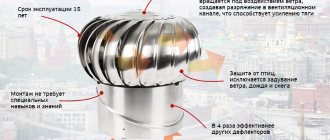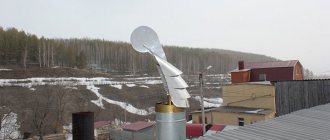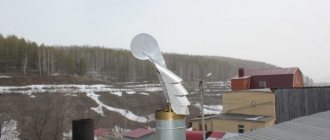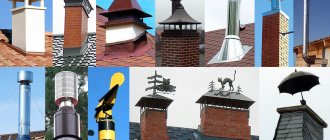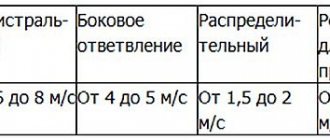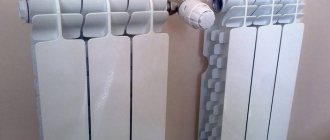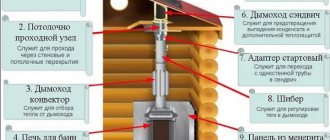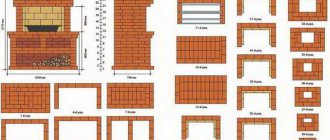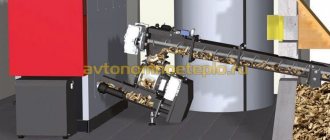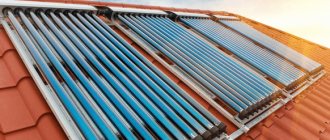Unlike chimneys, the heads of vertical exhaust ventilation shafts are always covered with umbrellas. It is undesirable for precipitation to get inside the air duct - the water has nowhere to go. The essence of the problem: the protective cap creates additional aerodynamic resistance to the air flow. The work of natural hood deteriorates, and if there is a lack of traction, it stops altogether.
The issue is resolved this way: a ventilation deflector is mounted at the end of the pipe instead of the traditional “fungus”. The installation is done by hand, but first you need to select the design of the exhaust device.
Why do you need a deflector?
For a better understanding of the issue, we present data from reference literature. The magnitude of local resistance to air flow in ventilation systems is characterized by the dimensionless coefficient ξ. The greater its value, the stronger the shaped element - umbrella, elbow, gate - slows down the movement of gases through the pipeline.
In relation to our cases, the coefficient is:
- at the exit of the air flow from an open pipe of any diameter ξ = 1;
- if the channel is covered with a classic cap, ξ = 1.3–1.5;
- a Grigorovich umbrella with a diffuser (section expansion) is installed on the pipe, ξ = 0.8;
- Volper nozzle is cylindrical or star-shaped “Shenard”, ξ = 1;
- TsAGI type deflector, ξ = 0.6.
Note. There is no mistake here - even with free release from the shaft, the air stream overcomes local resistance from sudden expansion. Source: Handbook of Heating and Ventilation, 1976 edition.
So, a deflector is a nozzle that, under the influence of wind, creates a vacuum at the outlet of the vertical ventilation duct and thus reduces the aerodynamic resistance to the flow. That is, it acts as a traction amplifier.
In addition, the exhaust device solves the following problems:
- protects the air duct from precipitation;
- does not allow the wind to blow inside the pipe;
- prevents the occurrence of reverse thrust (overturning).
The operating principle of any deflector is based on two effects: vacuum from the wind load and ejection (entrainment) of a slow gas flow by a faster one. Although some foreign manufacturers implement mechanical incentives - they simply equip the umbrella with an electric fan. Let us consider the structure of each design separately.
From this angle it is clearly visible that the cross-section of the lower nozzle pipe does not decrease, which means that the speed and pressure of the gases does not change
Comment. On the Internet, the operation of such caps is often explained by the action of Bernoulli’s law or the Venturi effect. Both physical phenomena involve a narrowing of the air duct, an acceleration of flow and a drop in pressure. In reality, deflectors do not reduce the cross-section of the channel (see photo above) - the vacuum is created solely by the force of the wind.
What should you consider when preparing ventilation?
1) The first point when designing ventilation is the mandatory air flow. Often they only think about the hood. Without air flow, none of the ventilation systems will work fully. Supply valve - must be used in any room
2) Ventilation should occur from the clean room to the dirty room. For example, in a residential building, ventilation begins in the bedrooms and ends in the kitchen and bathroom, where the exits to the ventilation shaft should be located.
3) When designing ventilation, it is necessary to take into account the type of room (for a vegetable storehouse and a chicken coop, different ventilation is required) and the number of users (the number of residents for a house, on farms the number of heads of livestock and their weight).
4) Area and cubic capacity of the room. The height of the shaft and the features of the ventilation duct (presence of bends and branches). Based on these data, it is calculated how much cubic capacity of air should be ventilated from this room and what volume the ventilation shafts and ventilation ducts should be, as well as the performance of the equipment necessary for ventilation.
Types of nozzles
Now you can purchase ready-made or make your own the following types of caps - traction amplifiers:
- TsAGI deflector with expansion of the ventilation duct - diffuser;
- Volper's cylindrical “mushroom”;
- H-shaped pipe manifold;
- cap - weather vane (popularly - “sycophant”);
- spherical rotary nozzle - the so-called turbo deflector;
- static-dynamic open device of the “Astato” type.
It makes no sense to include and consider ordinary umbrellas on the list - such products do not improve traction, they only cover the pipe section from the rain.
Construction of TsAGI type hoods
This design was developed during the USSR by a specialized research institute (scientific institute). The deflector consists of the following parts (shown in the drawing):
- lower glass with a diffuser (extension) at the end;
- outer body – shell made of cylindrical roofing steel;
- cover in the form of an umbrella;
- cover fastening posts made of metal strips.
The operation of the product is simple: wind blowing the body from any side creates a vacuum zone above the diffuser open at the top. The exhaust gases coming from the mine are carried away by this rarefaction, come out and are picked up by the wind - the ejection principle works.
The table below shows the characteristics of typical TsAGI deflectors - dimensions, performance depending on the wind flow speed.
Comment. Capacity does not include the resistance of the duct system crossing the roof. The actual exhaust volume depends on the height of the pipe and the temperature difference between the indoor/outdoor air.
Of all the static traction amplifiers, the TsAGI cap is recognized as the most effective, despite the venerable age of development. Design advantages:
- ease of manufacture and installation;
- maximum protection against rain and snow, and traction overturning;
- reliability, no rotating parts;
- the direction of wind flows does not matter;
- lowest resistance coefficient (ξ = 0.6).
The disadvantage of the deflector is its dependence on wind speed. If the flows move slower than 2 m/s, the efficiency of the device tends to zero. However, calm weather has a negative impact on the operation of any attachment designed to enhance natural draft in the ventilation duct.
The hood works thanks to wind support - a vacuum appears above the cut of the air duct
Please note: in modern versions of TsAGI factory-made, insulation of the lower glass is provided if the cap is attached to the roof sandwich pipe. Under the “fungus” we see a skirt, although the flow area of the channel does not decrease.
Volper Static Umbrella
This deflector is more of a windproof device than an amplifier of natural draft. Although the nozzle successfully compensates for pressure losses at the flow outlet. The design includes the following elements:
- lower pipe (glass);
- upper cylindrical glass with concave walls;
- cone umbrella;
- connecting strips.
The hood is installed on a round air duct or a rectangular shaft through an adapter. How the Volper ventilation deflector works:
- Direct wind flows are reflected up and down by the concave surface of the upper shell.
- The jet passing between the umbrella and the cut of the glass creates an area of low pressure inside the body.
- The exhaust air changes direction and flows out through the gap under the “skirt”.
The nozzle is inferior to the TsAGI design in efficiency, but better protects the air duct from gusts of wind. Making a curved glass is more difficult, so home craftsmen simply make a cone. To increase productivity, a similar plate in mirror image is placed under the umbrella, as shown in the video:
H-shaped nozzle
This original design is a pipe assembly in the shape of the Russian letter “H”, the hood is connected to the middle of an imaginary crossbar. From whatever direction the wind blows into the open pipes - from above or from below - the faster flow will eject (carry along with it) an air stream from the ventilation riser.
The advantage of the H-shaped deflector is almost one hundred percent protection against wind blowing, reverse draft, moisture ingress and freezing. These advantages are crossed out by no less significant disadvantages:
- Problems with aerodynamics - to go outside, the air travels through 2 90° turns. The losses are compensated by the wind flow, but the traction force increases minimally. Hence the low performance of the exhaust nozzle.
- The device is quite bulky, making it difficult to attach to the pipe.
- The H-deflector doesn't look very nice. Imagine a situation where 2-3 ventilation ducts with similar caps are installed on the roof.
The cap provides maximum protection from the draft being blown out and overturning, but it itself creates considerable resistance to escaping gases
Addition. We missed one advantage of the nozzle - it is easy to assemble it with your own hands from ready-made tees. The product can be used for ventilation of ancillary buildings, for example, a bathhouse or a warm barn.
Turbo deflectors and weather vanes
We have combined these 2 types of attachments into one section due to the similarity of the operating principle:
- A spherical rotary deflector with multiple semicircular blades is rotated by the force of the wind. A vacuum is formed above the head of the pipe (inside the ball), and the efficiency of the hood increases.
- The weather vane with the wing always turns its “back” to the wind, preventing it from being blown into the trunk. A zone of low pressure (aerodynamic shadow) is formed behind the nozzle body; the air stream leaves the vertical channel more readily.
The supporting element of the weather vane hood partially blocks the flow area of the ventilation duct.
In terms of efficiency, dynamic hoods are superior to static ones, but have a number of operating features:
- in calm weather, turbo deflectors and “sycophants” do not spin, and accordingly, they do not improve traction;
- the rotation unit - bearing or bushing - requires maintenance (lubrication), and risks freezing in winter;
- a jammed weather vane can be broken by a sharp gust of wind;
- The nozzles provide little protection from slanting rain or snow.
Reference. The prices of weather vanes and rotary deflectors are higher than static nozzles. Example: a TsAGI factory umbrella, made according to the 5.904.51 series, costs from 23 USD. e., turbo deflector – 38 cu. e. Conclusion: you will have to pay extra for efficiency, plus climb onto the roof every year and service the ventilation device.
How a weather vane works compared to an open pipe, watch the video:
Forced action hood Astato
This is the only type of deflector that operates in any weather, including complete calm. The nozzle is made of two truncated cones, with their vertices turned towards each other. The upper part is equipped with an umbrella and an axial electric fan. The opening on the side is covered with aluminum bird netting.
How does the deflector of the French brand Astato work:
- In windy weather, the hood acts as a static amplifier - the flow passing between the cones picks up the air rising along the exhaust shaft. The fan is turned off.
- When the wind subsides, the pressure sensor - pressure switch - is activated. It sends a signal to the EOL control unit.
- The controller starts the fan at the desired speed (there are two in total). Forced suction from the canal begins.
Note. The sensor response threshold is configured by the user. A static-dynamic device can operate without expensive automation - from a temperature relay, or be switched on manually.
The only drawback of the Astato active deflector is the price, which is astronomical by our standards. To buy a nozzle with a minimum diameter of 160 mm, you will have to pay 1395 euros. If you want to automate the operation of forced exhaust, add here the cost of the EOL unit - another 1,520 euros.
The deflector is an integral part of the ventilation system
Deflector with a skirt
The organization of air exchange in the house is carried out by a system of elements, components, mechanisms that ensure its multifunctional action: inflow, removal, ozonation, air heating and other operations. The exhaust ventilation deflector plays an important role in it. The aerodynamic device is equipped with a “cap”. It is installed on the roof on top of the exhaust ventilation pipe at the highest point. Functions:
- Protects the ventilation duct.
- Creates uninterrupted draft for the entire ventilation system and activates its operation.
The design varies, but there are common basic elements:
- Two glasses: the outer one is slightly widened at the bottom, the inner one is flat.
- An umbrella (cap) is a protective element that prevents the entry of airborne debris, precipitation, and small insects.
- Brackets for fixing the cap.
- Pipe branch.
- Some devices are equipped with a protective mesh that prevents debris from entering the pipe, but weakens the draft, although not significantly.
The shells of the housings are in the form of cylinders, which are put on one another. A lid is attached to the top one. The top of each cylinder is equipped with rings. This type of deflection is designed to adjust the direction of air flow in a ventilation deflector of various sizes. Their installation is planned so that the penetrating air flows create air suction through the leaks between the rings, thereby accelerating the removal of gases from the ventilation.
Which deflector to choose
If you want to install a cap - a traction amplifier at minimal cost and not maintain the product during operation, we recommend choosing static models - a Volper or TsAGI deflector. The latter option is preferable for making it yourself.
Advice. Select the size of the nozzle according to the diameter of the exhaust barrel. If a rectangular shaft is removed from the house, the selection is made using an equivalent circular section. That is, it is necessary to calculate the diameter of the channel, then take a circle of similar area. An adapter is used during installation.
Recommendations for choosing different deflectors:
- If there is insufficient or no draft, it is better to install dynamic versions of the hoods - rotary or weather vane.
- When buying a rotating nozzle, do not go cheap. Inexpensive products use an open hinge - a regular bushing that will freeze in winter. Choose a weather vane or turbo deflector with a sealed bearing.
- An H-shaped cap is useful in areas with constant strong winds. In other cases, it is better to take TsAGI.
Purchase Astato deflectors if desired - the amplifier will work in any conditions. But remember: the moving parts of the nozzle need to be serviced periodically.
Advantages and disadvantages
To increase draft, an electric fan is additionally installed in the ventilation duct.
A ventilation deflector to increase draft effectively protects the ventilation system from dirt and precipitation. If the deflector was calculated correctly, the ventilation efficiency increases by 20%.
If there are weak winds in the area, it is best to install a device on the system to enhance the exhaust and inflow of air. In this case, the effect of thrust overturning will be completely eliminated.
The device has a number of disadvantages:
- If the wind direction is vertical, the flow will come into contact with the top of the structure. This will result in the air not being able to be properly vented outside.
- In winter, ice forms on the base of the pipe. To avoid problems with the functioning of ventilation, you need to regularly arrange preventive examinations.
To combat the first disadvantage, designs were invented that are equipped with two cones.
Do-it-yourself production
We propose to explain the technology for assembling the cap using the example of a TsAGI type nozzle. The parts are cut out of galvanized steel 0.5 mm thick and fastened together with rivets or bolts with nuts. The design of the exhaust element is shown in the drawing.
To make it you will need a regular metalworking tool:
- hammer, mallet;
- metal scissors;
- electric drill;
- vice;
- marking equipment - scriber, tape measure, pencil.
The table below shows the dimensions of the deflector parts and the final weight of the product.
Reference. The most common diameters of ventilation ducts are 100 or 110 mm, when the hood is made of a plastic sewer pipe.
Pattern and drawing of an umbrella with a cap with a diameter of 100 mm.
The assembly algorithm is as follows. Using scissors, we cut out the blanks of the umbrella, diffuser and shell using the developments, and fasten them together with rivets. Cutting the shell is not difficult; the development of the diffuser and umbrella is shown in the drawings.
Opening the bottom glass - an expanding diffuser
The finished deflector is placed on the head, the lower pipe is tightened with a clamp. For a square shaft, you will have to make or buy an adapter, whose flange is attached to the end of the pipe.
How does the collet deflector work?
This device is a structure made according to the cross-sectional shape of the ventilation shaft. Below is a figure that schematically shows all the components of the device.
- The pipe is attached to the head of the ventilation pipe.
- The diffuser is a truncated cone, which is attached to the pipe with its narrow part.
- The ring is the main visible part of the device, which is mounted on the outside of the diffuser using brackets.
- The umbrella protects against debris and precipitation getting into the channel. Mounting is done using the same brackets as the ring.
Can it be installed on a chimney?
By installing a deflector, unlucky homeowners are trying to solve the problem of lack of draft. This happens when the chimney pipe is made incorrectly - the head falls into the zone of wind support of the roof, is raised to a low height, or a neighbor has built a tall building nearby.
The best solution for insufficient draft is to raise the chimney to the required height. Why is it undesirable to jam various attachments onto the head:
- It is prohibited to place umbrellas and other exhaust devices on pipes that discharge combustion products from gas boilers. These are safety requirements.
- When burning, stoves and solid fuel boilers emit soot that settles on the internal surfaces of chimneys and caps. The deflector will have to be cleaned, especially the rotating one.
- At the bottom of a properly constructed smoke channel there is a pocket for collecting condensation and excess moisture. There is no point in covering the pipe from precipitation; it is enough to attach a nozzle at the end that protects the insulation of the sandwich.
The heads of stove flues can be equipped with umbrellas, but a turbo deflector is definitely not needed there. The topic of installing hoods on smoke exhaust ducts is covered in detail in a separate material.
The tasks of deflectors and their purpose
Wind has a significant impact on the efficiency and operation of the ventilation system. In the summer, due to an increase in the temperature of the external environment, its indicators are compared with the temperature regime inside the house. This reduces traction and reduces air circulation.
The influence of the described negative weather factors can be significantly reduced by directing them to the benefit of the ventilation system. For this purpose, special aerodynamic devices are used - deflectors operating on the Bernoulli principle. To best fulfill their purpose - to increase the traction force inside the ventilation system by using air pressure, they are installed at the pipe outlets at their highest point. Similar devices can be seen on the roofs of public and administrative buildings, houses, garages, on pipes from basements and basements.
Deflectors can even be installed on the roof of a garage
Why do you need a deflector? It has several key features:
- Protection of ventilation ducts from contamination and birds from outside. Particles of small debris, grease and dust accumulate on the walls of pipes, reducing their internal diameter over time, reducing their service life.
- Obstacle to precipitation.
- Activation and enhancement of traction. The described device increases the efficiency of the ventilation system by 20%.
- Spark arrestor. To maintain fire safety, install a deflector on the chimney.
Features of choice
Plastic, stainless and galvanized models are available.
There are many types of wind devices. They are divided into groups depending on their structure and operating principle. When choosing a suitable model, it is recommended to pay attention to the following nuances:
- construction material;
- operating principle;
- individual features of the device.
Material of manufacture
Most often, wind nozzles are made of stainless steel, plastic, galvanized steel, and aluminum. The simplest models can be made independently. The most practical are structures made of aluminum and galvanized steel. Such products made from copper can rarely be found, since their cost is quite high. Only base structures are made of plastic, since the material is very fragile. The deflector intended for the chimney is made of metal.
Classification by operating principle
Movable models are more effective.
Varieties based on the principle of operation of the nozzles:
- Static ones are the simplest structures that you can assemble yourself. They are installed on ventilation ducts in high-rise buildings and small enterprises.
- Turbo deflectors are structures made of rotating blades. The base is completely static and the head rotates.
- A weather vane installed on the ventilation duct shaft. It rotates according to the direction of the wind.
By installing a deflector, you can protect and extend the service life of the ventilation system, as well as improve its performance.
How to glue deflectors to a car - installation nuances
Having found out what a car deflector is, you also need to figure out how it can be glued to the surface. However, keep in mind that sometimes you come across bad adhesive tape that will not secure the part properly, this is another reason to buy only high-quality products. Typically this procedure takes no more than 10 minutes and consists of the following steps. First you need to try on the accessory so that it does not interfere with the view (especially if we are talking about window deflectors), is located in the center, etc. Next, degrease the surface with a special napkin (it should be included in the kit).
Now you should separate 5 cm from both sides of the edge of the protective film from the double-sided tape and glue the part. If it turns out uneven, then you need to immediately re-glue it, and when the work is done perfectly, you need to pull the tendrils of the protective film and press the deflector for a while. There is also a universal car deflector holder; this device is attached through the ventilation panel and is used as a stand for mobile phones, tablets and other similar equipment.
Home →
Operation → Accessories →
Is it possible to make a rotary deflector with your own hands?
Simpler types of deflectors, which have been used in practice for a long time, are often made by skilled householders on their own. In principle, a technically savvy person can handle this work. True, this will require developing a working drawing of the future design, correctly taking measurements, and developing a diagram for installing the deflector.
Regarding the turbocharged variation, not everything is so simple - it is a technically more complex design. Therefore, almost always, having decided to use a rotational model, they purchase it in the form of a professionally manufactured product.
Read with this
- Using ventilation turbo deflectors
- Backdraft in the chimney
- Types of chimney pipe caps and do-it-yourself element installation
- Coaxial chimney for gas boiler
- Dimensions and installation of pipes for a bath
- What sizes of sandwich pipes are best to use for a chimney?
- Chimney in the garage through the wall: stages of arrangement
- Disadvantages of polypropylene pipes in home heating
- Why chimneys become contaminated with soot and how to get rid of it yourself
- How to assemble a simple stainless steel chimney
Installation of a chimney on the roof
There are two options for installing the deflector: connecting directly to the smoke duct and mounting it on a piece of pipe, which is later put on the chimney. The second method is considered the best in terms of convenience and safety, because the most troublesome stage of the work is performed on the ground, and not on the roof.
Standards according to GOST
Excerpts from current regulatory documents regarding the installation of a deflector on a pipe inform about the following:
- any nozzles on the smoke channel must be mounted in such a way that they do not block the path of fuel combustion products;
- on a flat roof, the mouth of the pipe should be placed above the fence;
There should be free space around the mouth of the pipe - on a roof with slopes, the chimney head must be located above the ridge, if the space between them is less than one and a half meters, or at the level of the ridge, when the gap from the pipe to the highest point of the roof varies within three meters;
- the deflector must not be installed in an area where an aerodynamic shadow is created due to neighboring buildings;
- the device body must be well ventilated regardless of the wind direction;
- rotating deflectors are not suitable for chimneys of stoves located in houses built in areas with cold winters;
- installation of a round deflector on a brick chimney involves the use of special transition pipes.
Required Tools
To install the deflector on the smoke duct, you need to find some tools and fasteners:
- electric drill;
- open-end wrenches;
- threaded rods;
- nuts;
- clamps;
- two ladders (one for climbing to the roof, and the other for moving along the roof).
In addition, to install the device on the chimney you will need a piece of pipe. Its diameter should be slightly larger than the size of the smoke channel.
Deflector mounting
The chimney is connected to the pipe, performing certain tasks:
- On the prepared section of pipe, 10 cm from the edge, mark the points where you need to drill holes for fasteners. Similar marks are left on a wide area of the diffuser.
- Holes are made in the pipe section and diffuser with a drill. The parts are temporarily connected to each other, checking that the upper and lower holes match. If this is not observed, then the product is considered defective, because the fastening elements cannot be inserted smoothly.
- Pins are inserted into the holes. On both sides, both on the diffuser and on the piece of pipe, the fasteners are secured with nuts. They are twisted evenly to protect the product from deformation.
- With the manufactured device they are sent to the roof. The structure is placed on the smoke duct and tightened with clamps.
If you install a deflector on a brick chimney, you will have to arm yourself with nails and a hammer
Proceeding as described above, you can mount any device except the weather vane deflector, since its design is rather non-standard.
In the case of using a device with a compass rose, 3 holes are created in the smoke channel with a drill. The holes are made at the same level so that bolts can be inserted into them a little later. These fasteners are immersed in the holes when the ring part of the deflector-vane is placed into the cut of the chimney. An axle is inserted into a bearing in the form of a ring, and a cylinder, a device blade and a cap are alternately attached to it. The elements of the weather vane deflector are combined with brackets or rivets.
The deflector can confidently be called a useful device that has a positive effect on the draft force in the chimney and the functioning of heating equipment. It is relatively simple to make and connect the device to the pipe; you just need to be “savvy” in choosing the type of deflector.

